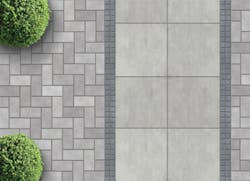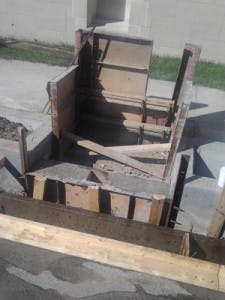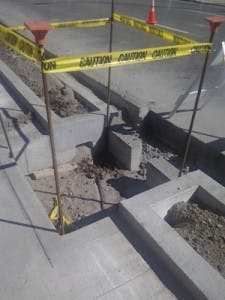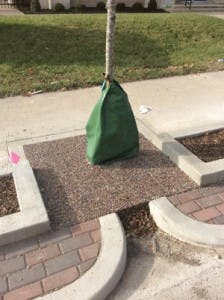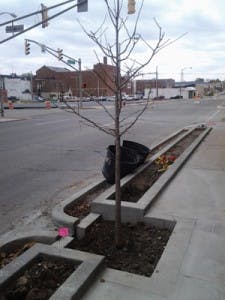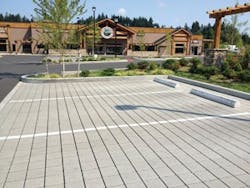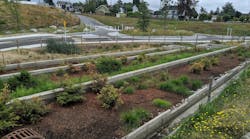Sinking wheels, muddy feet, lame horses and livestock, trade goods ruined—these might have been just a few of the reasons why humans developed pavers thousands of years ago as an answer to a better surface. While the Romans come to mind as the first to build paver-based roads around 156 AD, they had adopted the process from the North African Carthaginians of Tunisia, where historians estimate pavers were already old news, in use for at least 500 years prior. In fact, many of these first stone paver roads can still be seen today.
Fast-forward a few thousand years and pavers have changed little; they are sometimes square but most often rectangular, usually twice as long as wide. But their manufacture has leaped into the 21st century by adopting new technology, engineering, and materials.
Today’s pervious, permeable, and porous pavers truly meet the message famed architect Louis Sullivan preached: “Form follows function.” What could be better than an aesthetically pleasing product that can also function as an onsite stormwater and erosion control manager?
Today’s High-Tech Pavers
Mark Walker, director of development for Kuert Concrete Inc. in South Bend, IN, the Midwest distributor of Xeripave, explains how pavers now fall under “one of the three Ps”: “First, there are pervious pavers, and we compare those to permeable and porous pavers; all have their own distinct characteristics, but the difference between them is how stormwater infiltration is managed by the paver.”
Walker says water actually flows through the Xeripave paver itself to the underlying stone and soil layers, eventually replenishing the area’s aquifer. He adds that minimizing stormwater runoff has a direct effect on minimizing downhill erosion issues, and it’s a perfect solution where stormwater management—along with erosion control—needs to be addressed.
Because the pavers do such a great job of infiltrating surface water, only 15–18% of the overall surface of any given project requires Xeripave. This allows the use of other surface materials such as asphalt or concrete, thus minimizing project costs.
“These perform the same function as traditional hardscape products, but as they are totally pervious, there is never any standing water. In fact, ice can rarely form because water doesn’t sit on the surface, making it perfect for pedestrian walkways and parking areas.” He says the pavers have UV resistance to increase product longevity.
Although Xeripave pavers have been used extensively for walkways in front of public buildings such as railway stations, hospitals, and banks, Walker is very enthusiastic about the project completed by the city of Anderson, IN. He describes the novel use of the pavers as “like nothing I’ve ever seen in my travels around the country, and one that should be commended not only for its ingenuity, but for its contribution toward accelerating cost-effective green stormwater infrastructure.”
Downtown Beautification Takes Off
Located northeast of Indianapolis, Anderson is home to 55,000 residents and one very creative assistant stormwater manager named Jeremy VanErman, who says the project began with the mayor wanting to do some downtown beautification.
“Because of our budget, we had to whittle this down to one street instead of two, and we did some preliminary drawings and conceptual planning, thinking first we would green it up with some trees and hardscape.”
Constructing the tree planters. Curb turn-ins divert water to the trees.
But as the city found a lot of concrete deterioration, mix-and-match repair work, and instances of noncompliance with the Americans with Disabilities Act (ADA), VanErman says it also discovered that significant underground electrical components had failed.
Because the city has its own electric company, and anticipating future needs, VanErman’s team talked to the utility about putting in new conduit for the future that would accommodate traffic, safety, decorative lighting, and more.
“Trees, green space, and sidewalk repairs then became our scope after our needs analysis,” says VanErman. “At first we wanted to put in planter boxes, but I didn’t want to add burden to the parks people for watering and maintenance. Plus, we’re a combined sewer community, so when I devised the project in its final form it was really to reduce the workload of our staff.”
VanErman’s ingenious solution to manage the proposed new greenscape while reducing a watering maintenance effort was to capture the street stormwater and divert it to the treewells.
“I thought about turning the curb water into the trees, and one thing led to another. The design we came up with was to build curb turn-ins, and then I talked to Mark Walker about Xeripave. He helped us come up with an alternate design to accommodate the benefits of using pervious pavers.”
What they ended up doing was using the Xeripave around the trees, “like a rain garden on steroids,” he says.
Constructing the tree planters. Curb turn-ins divert water to the trees.
“I didn’t have underground storm piping, so without building a rain garden, turning the water in and opening its passage to the trees through the curbs became my answer.
On the surface around the trees, the water passes directly through, and water from curb turn-ins passes through a Xeripave standing on end, allowing the street water to enter but blocking silt and trash.
“We had to support the pavers over a bridge gap, but we saw the flow rates and thought there shouldn’t be any reason it wouldn’t take a ton of water just by turning it on end,” he says. “This saturates the soil of the tree root ball and the sandy soil that backfeeds it. It’s a natural watering structure.”
The structure also accommodates growth of the tree trunks over time.
VanErman says the project has been about two years in the making, three years from start to finish. The original cost estimates not including the decorative streetlighting were around $1.2 million.
“We’re at 90% right now, and businesses love it, the look and the feel of the surfaces. Our arborist, Greg Spencer, helped pick out the most suitable plantings, and also trees that are salt tolerant for winter treatments as well as hardy and that can take a lot of water.”
Moreover, he says, it’s a model best management practice (BMP). “This project will do well as a BMP for the city; it’s a huge BMP for stormwater, groundwater infiltration, and offloading a lot of rainwater. We’re going to use it on another project since the pavers performed so well. Hopefully, Main Street is next, to be funded by the City Redevelopment Commission, Economic Development and Revitalization.”
Constructing the tree planters. Curb turn-ins divert water to the trees.
While VanErman concedes that there is a certain amount of maintenance—sediment that collects from the curb turn-in must be shoveled out—the benefits far outweigh those issues as the upside on low-cost maintenance is a “no brainer.”
“If there’s any work to be done, these pavers can be removed far less intrusively and then replaced easily. For the electrical maintenance, this means not having to tear things up and then try to cosmetically patch them back together,” he explains.
“As far as I know, no one else has done this design element—no curb turn-ins and none combined with Xeripave. We have about five to six thousand cars a day go through this renovated block, and I hear good things all the time.”
“Form Follows Function”
Often dubbed the “father of the skyscraper,” Louis Sullivan, the dynamic turn-of-the-(last) century Chicago architect, helped redefine the skyline of Chicago with new geometrical concepts and ornamentation. Although not everyone is familiar with his Carson Pirie Scott department store in Chicago, or the Buffalo, NY, Guaranty Building, nearly everyone has heard his design mantra “form follows function”—a phrase often (and mistakenly) assigned to his renowned chief draughtsman, Frank Lloyd Wright.
Unanticipated Stormwater Surprise
At Chuck’s Produce in Vancouver, WA, the family-owned grocery has a mission to provide fine specialty foods—many organically grown—with varieties catering to the most sophisticated epicurean and to the family dinner table. The store’s motto, “You never go wrong doing the right things,” translates to both the products and service indoors, and to the aesthetics and environmental sensitivity of the hardscape outdoors.
John Meier, P.E., of Vancouver-based AKS Engineering and Forestry says installing 15,000 square feet of permeable EcoPriora pavers at the site “wasn’t easy, but it was a fun project.”
The site had stormwater runoff issues, a sticky problem the owners discovered as they were preparing to build the 45,000-square-foot retail store.
“It turned out the facility was oversized for the proposed stormwater plans, so alternative solutions had to be found to manage stormwater onsite. The property happens to be within a critical aquifer recharge area with a wellhead across the street; we were limited on the type of infiltration we could do onsite,” says Meier.
The receiving water for runoff from Chuck’s Produce is the Salmon Creek, which, he says, “is a fish-bearing stream requiring enhanced water-quality treatment.
“We had two options for stormwater: permeable pavers or rain gardens. So, we did both,” says Meier.
“The aesthetics of the property were very important to the owners. They wanted the grounds and exterior to convey the same message and feel of quality, environmental sensitivity, and community interest outdoors as they do inside the store.”
Meier says the county had recently instituted a fast-track program for urban development. “You could do land-use review and civil engineering at the same time. The site happens to be in an overlay area, and there were new standards for redevelopment. The combined review process was very good, and we had a good team of owner, consulting engineer, and contractor.”
Instead of building a pond, the owners had options of concrete, asphalt, or pavers, but the owners liked the look of the pavers. In view of the long-term survivability and ease of maintenance over other products, “it just made sense to go with permeable pavers,” says Meier. But protecting the watershed required additional preparation of the underlying soil.
“We had to have enhanced treatment and had to so some underlying soil amendment, to make sure of the content [so it] would permit a chemical exchange process. We also put down
2 to 3 feet of coarse gravel, as the water from the roof of the facility also drains under the pavement and goes to a huge stormwater header pipe.”
Pavers Exceed 100-Year Storm Requirements
Fred Davis of Vancouver-based Mutual Materials says his company is a licensed manufacturer of Uni-Group USA to manufacture EcoPriora.
“These are interlocking pavers that come in 4 by 8 and also 8 by 8 sizes, and whose water carrying capacity takes place in the spaces where they are interlocked, which is filled with small aggregate stone allowing water to pass directly through that space.”
He says the pavers have a significant advantage over porous surfaces, as they can manage water for up to five times their installed space. “In other words, if you install 30,000 square feet of EcoPriora, you actually can manage water from a surface five times as large, or 150,000 square feet.”
Although tests have shown that the pavers can infiltrate as much as 165 inches of water per hour, which is good to know, he adds humorously, “If we ever get that much we’ll be calling Noah!” Nonetheless, using the product in a region with an average rainfall of 35–45 inches per year, all occurring in the winter months, ensures that the store’s customers will rarely get their feet wet on the walkways or parking lot.
Spokesperson Matt Harrell from Chuck’s Produce says, “I don’t think the public even knows this is a permeable paver system.” But what they do know is that on rainy days the EcoPriora is doing its job. “There is no water ponding at all, and also no erosion on the site.
“Erosion is a big thing,” he adds, “because if there was a 25- or 100-year storm event, silt-laden waters could leave the site. Everything is underground and percs to the Salmon Creek drainage basin. We couldn’t just put a pond in, because if a pond overflow occurs, the silt could leave in the form of a discharge; in our system there is no opportunity for that.”
Meier adds that although the cost for the permeable interlocking pavers is about double that of conventional asphalt, it was cheaper than building a pond or installing underground detention. “Plus, if we had underground detention, we couldn’t infiltrate into the ground, and we can’t have that because of state standards in a critical aquifer recharge area such as this.”
Harrell says some maintenance is required. “You have to have street sweepers go over the seams every so often, as they will start to silt up.” But the important piece of the project is the positive response from Chuck’s Produce customers.
“We’ve heard how they appreciate the color tones and like the aesthetics. A lot of people won’t even pick up on it, but we colored them differently—the parking pavers are grey, the pedestrian traffic pavers are red. The drive aisles are asphalt, but they are crowned in such a way that water flows to the parking galleries where it can infiltrate through the paver system.”
Today, the nearly 2 acres of pervious pavers look good are performing well. “We are definitely happy with the way this project turned out,” says Harrell.
Pavers Make the Honors Roll
Two hours west of Boston, the University of Massachusetts, Amherst, is home to an unusual facility where half of the 3,000 enrolled students can experience a first-of-its-kind opportunity in both learning and living arrangements.
The half-million-square-foot complex of seven buildings is known as the Commonwealth Honors College Residential Complex (CHCRC). It includes residences for students and faculty, classrooms, administrative offices, and a 24-hour cafe.
The university’s largest single construction project to date, the CHCRC is a LEED Gold project whose structures have the unifying aesthetic feature of more than 20,000 EcoPriora interlocking pavers throughout the walkways and courtyards.
The university created the project with the intent of attracting academically high-performing students who might otherwise head in the direction of Ivy League environments, but are unable to pay the stiff price tag of those schools. Through sophisticated design and use of brick, stone, and aluminum, the honors students at UMass Amherst now have a physical setting similar to many higher-priced private schools to call their own for honors classes and events. The walkway of permeable pavers creates a thoroughfare that links to the rest of the campus and is used by all students.
Quality Product Brings Quality Aesthetic
Chris Fee, RLA, project manager at landscaping firm Stantec, says, “We knew we were shooting for the LEED Gold, and incorporating a certain amount of permeability was an attractive way to go.” The team selected the granite-look finish from Unilock, the local manufacturer of EcoPriora pavers.
Permeable paver lot in front of Chuck’s Produce
Fee describes why they chose EcoPriora: “It looks more like a traditional paver, and the joints act as a locking unit. We wanted a look of a traditional paver and one that was heavy duty, but gave the permeability that satisfied LEED, which requires a certain percent of groundwater recharge.” He says the locking design prevents the pavers from shifting, and the look is consistent in its spacing with permeable aggregate between the pavers. “You can’t use sand in the joints because it clogs and then affects the permeability,” he notes.
And in a climate of heavy snowfall, the product prevents the icy surfaces pedestrians dread. “This year (2014–2015) is our second winter, and after snow-plowing with a rubber-coated blade, we don’t need salt because water leaves the surface and there is no freeze-thaw cycle,” he says.
Amherst is part of the Mill River Valley, and the “subgrade was not great,” explains Fee. “There was enough clay to cause concern that the groundwater recharge would be slow, and we were advised to make our stone reservoir beneath the pavers deeper than the standard 18 inches.”
Fee says excavation was extended to 3 feet to ensure proper infiltration and recharge. “We cored some holes in the catch basin structures so if there was overflow it would trickle out.”
The LEED Gold certification was a driving force in the selection of the permeable pavers. “We like to be environmentally responsible. The money isn’t always there, but if you measure the upfront costs and balance against energy benefits, lower maintenance costs, and higher efficiency, it’s a good choice, and it lends prestige to your project. We feel good about using it.”
The university loves it, says Fee. “This is the flagship part of their campus, and it’s a big selling point because they can promote the LEED Gold, and the pavers contributed to that.”
The university community feels good about its new honors environment as well. Students voice appreciation about the unique setting where taking classes together at the CHCRC and living down the hall, rather than across campus from each other, fosters friendships and a richer learning experience.
A Family Holding Creates a Legacy
Less than 20 miles south of the West Virginia panhandle is Winchester, VA, in the Shenandoah Valley. Long known as the “Apple Capital,” this historic town of 24,000 is surrounded by vast orchards and constitutes one of the largest apple export markets of the nation. It is the largest producing area in Virginia. And now, it will also be home to a new 5-acre subdivision known as Doonbeg. Mark Smith, P.E., LS, president of Greenway Engineers and the project’s owner and developer, says the development takes some of its inspiration from Ireland.
“Doonbeg is a private, small-lot subdivision whose name was inspired by the same-name town in West County Clare on the Atlantic coast of Ireland, which my family and I visited,” he says.
The 25 cottages being built on the 5-acre site each have a 4,000-square-foot lot that will get full exterior maintenance. Smith adds that the additional 1.4 acres of open space is enhanced by mature trees.
“There were seven large maples and oaks that had been planted on this tract years ago, and since it is a private property, we saved them by designing our road between these trees, which really adds to the look and prestige of the site.”
But what really sets Doonbeg apart from other subdivisions is the visual landscape of thousands of pavers that comprise roads, walkways, driveways, and sidewalks. They not only look good but also are critical to the stormwater and erosion management of the property.
“We wanted the appeal of a brick street,” says Smith. “As we did research and got connected with Eagle Bay Stormwater Systems and SWMpave stormwater products, we found we could easily satisfy the stormwater regulations for Virginia with the use of these pervious pavers for our 1,200-foot-long street.”
He says the stormwater management requirement actually worked to their advantage, explaining that the property was an infill site surrounded by development but left vacant for years “because nobody could figure out the stormwater piece.”
But by using the more than 75,000 pervious SWMpave pavers to satisfy stormwater mandates, the site is stormwater compliant and has also gained the benefit of an entire extra lot within the subdivision.
The 2.5 feet of stone under the road meets the necessary void ratios. The nearly one-quarter mile of street pavers was installed by a mechanical paver company that completed the project in just two weeks.
Another engineering coup was the minimally invasive erosion control effort. Smith says that in Virginia, erosion control typically requires the installation of a silt fence, which itself can disturb the soil.
“Virginia does not utilize silt socks, which is a filter sock full of mulch. You lay it on the ground and drive stakes through it to hold it in place and you don’t have to rip up the ground and disturb soil.”
He convinced regulators to allow a test case for using a silt sock instead. It worked so well in demonstrating how soil is less disturbed and how it controls erosion that a waiver was granted for Doonbeg to install the silt socks throughout the property.
Smith says his rationale for selecting pavers and pervious pavers was a cost-benefit decision. “I considered if I put asphalt in it will cost me X, and I knew over a certain period of time I would have to repair it. My process told me to spend the extra money on pavers and by doing it up front I would recoup the investment in the long run.”
He adds that he was sold on the interlocking SWMpave pavers because he had seen how interlocking pavers are used in shipyards.
“I saw how they were in use for the extremely heavy-duty weight-bearing demands of the Baltimore ship yard. So I figured if they can stand up to that, they can certainly withstand anything we might do here.”
As the project rolls toward completion, Smith is confident in his decision to create a unique niche lifestyle in the Apple Capital.
“The road and utilities are in; we’re doing seeding and grading. The test house has radiant floor heat, and we’ve put in hardwood and tile and rounded corners. The whole project benefits from our travels, which have provided us with ideas to bring back and incorporate into this project.”
Smith says he was fortunate to have collaborators with high skill level to help realize his dream of Doonbeg.
“This works for us as the property is part of our family holdings, and this project will pass on from myself to other family members.”